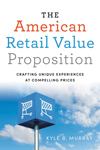For retailers, the shopping environment is a combination of many decisions, including the store location, format, layout, and design. At the core, however, decisions about the shopping environment are not about locations or formats or layouts or channels or media. They are about the customer.
The shopping environment is the context within which customers finalize their purchase decisions and spend their money. It is the place where retailing happens. Selecting that place may be the single most important decision retailers make, because store locations tend to have a major impact on who the customers will be.
Competition
Location decisions also directly impact retailers’ competitive positioning. Over the years, Lowe’s and Home Depot have aggressively acquired many of the best big-box locations for home improvement in the United States. As a result, new start-ups or existing businesses looking to expand will be faced with the challenge of finding suitable real estate that is not already occupied by their competitors.
Convenience
From the consumer’s perspective, location is primarily about convenience. When market researchers ask consumers about the most important factor in their store choice decisions, convenience regularly tops the list – not surprising in a society where time is more valuable than money for many people.
Convenience, however, does not always refer to the store that is closest to home. In fact, the most convenient grocery store might not be the one closest to your house but the one on your route home from work. The most convenient dry cleaner could be the one beside your kids’ school, and the most convenient restaurant might be the one next door to the movie theater. Ultimately, convenience is about making it as easy and efficient as possible for customers to complete a purchase.
The Location Decision
Successfully choosing a store location requires a deep understanding of the customer segments the retailer aims to serve. Specifically, before finalizing the location decision, retailers tend to follow a process that includes the following steps:
1 Select the general geographic area. Often it makes sense for a retailer to develop a critical mass in one area before expanding into new ones. For example, a retailer with a chain of stores in Houston and San Antonio will generally be more successful moving to Austin before expanding to Pittsburgh or Seattle. Regardless of the strategy that underlies opening a new store, the first step is to select the general region in which that store will be located.
2 Map the market segments within that area. The next step is to map out the local market segments. Ideally, the new store will open in an area that contains, or is expected to attract, a high percentage of consumers within the segments the retailer is targeting.
3 Map the competitors within that area. At this stage, a retailer should consider the level of market saturation – that is, the number of competitors in the area relative to the number of customers being served. Entering a saturated market with established competitors is generally not the best investment. When mapping competitors, retailers should also consider customers’ routes of travel and the ease with which they can access the new store relative to those of the competition.
4 Map complementary businesses within that area. Retailers need to consider the effects of complementary businesses in the area. Many retailers like to be located near high-traffic businesses such as grocery stores or in busy malls, especially if those companies tend to draw the retailer’s target segments to the area.
In other cases, neighboring retailers can make a new store more convenient. For example, a cheese shop located next to a deli and a bakery is likely to be more attractive to consumers than one located next to a bookstore and a convenience store.
5 Identify and evaluate potential sites within the mapped area. Of the available sites that now remain, the retailer should further narrow the list based on the ability of the site to support the desired store size and format, as well as other considerations such as business licensing and the terms of available leases. Last, but not least, the retailer should conduct a review of the trade area, which defines the types of customers the store is most likely to attract. Each retailer has different priorities when evaluating a prospective site. Depending on the retailer’s overall strategy and its strategy for the specific store, it might choose to emphasize one or more of many potentially important factors, ranging from development costs and desired formats to traffic and competition.
6 Finalize the store format. The retailer’s desired store format should be integrated into the location decision. Stores meant to serve an urban population have a format and footprint that is distinctly different from those meant to serve suburban or rural populations. Nevertheless, in the process of matching available real estate to retail strategy and target customer segments, the format of the store requires some modification and adaptation.
Location and format decisions reflect the intersection between available real estate, target segments, retail strategy, competition, and sustainable profitability. Often, the ultimate decision is a compromise between the ideal and the available. Retail real estate choices result in significant investments that are not easily changed in the short term. While many aspects of retailing – such as product selection, merchandising, employee training, advertising, and so on – can be adapted and revised in the short term, locations and formats tend to have more enduring effects on revenue and profitability.
As a result, it is important for the modern retail manager to be familiar with the process of choosing a location and store format. If location is about convenience for the customer, then location and format decisions are about making consumption as convenient as possible for the right consumers. Of course, there are other concerns about profitability, but first and foremost, location is about revenue – that is, getting the right customers to spend at your store and not those of your competitors. Without revenue, there is no profit.

